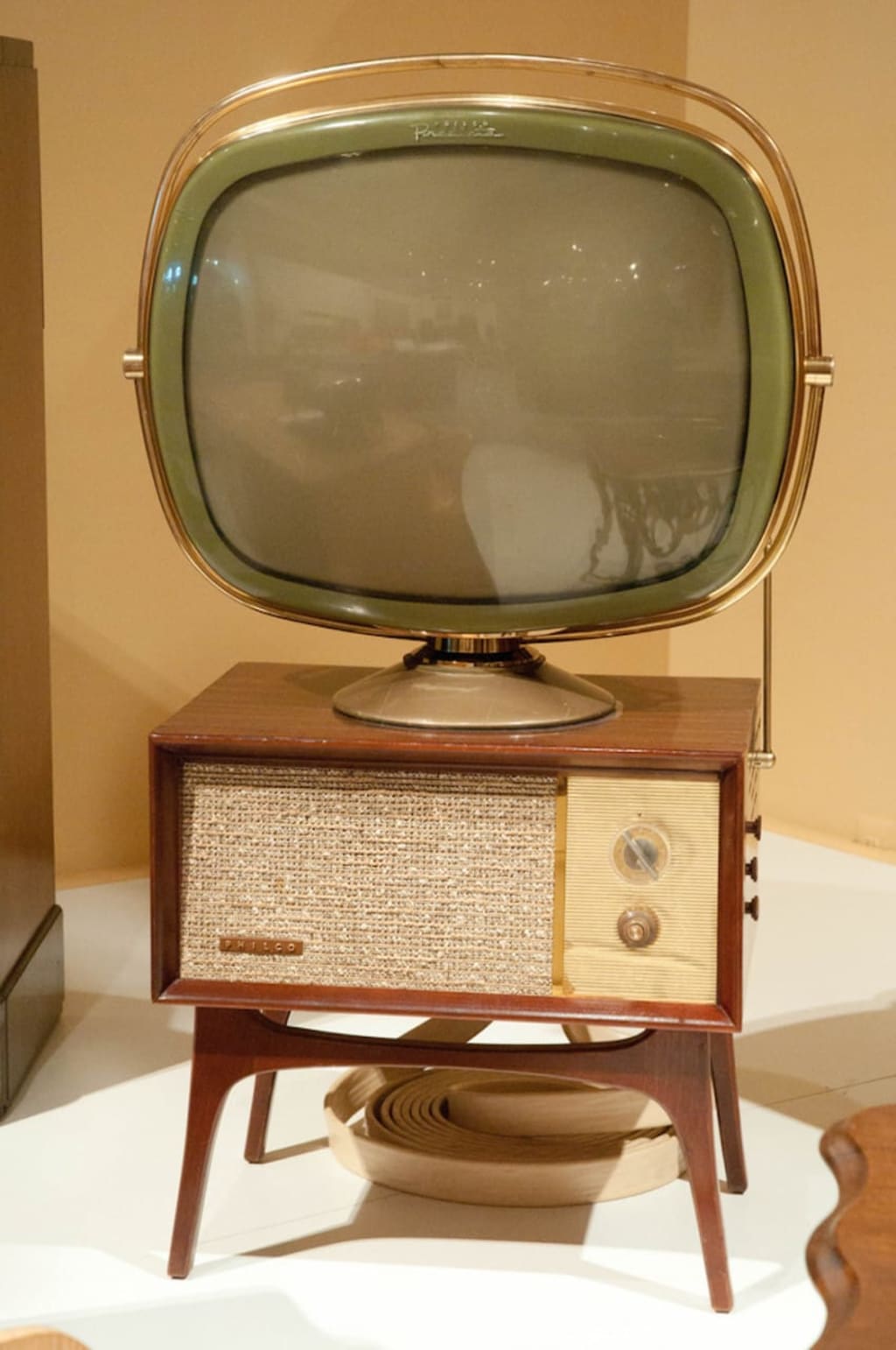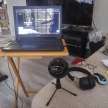The 1950s Science Fiction Podcast. S1:E2
Sci-fi TV shows.

Start of Transcript:
Introduction:
Hello everyone, and welcome to The 1950s science fiction podcast. I hope that you have listened to and enjoyed episode one of the show. In episode one, I talked about 50s sci-fi radio dramas and how great they were. Today I will discuss the science fiction programs broadcasted on Television during the decade. The broadcast TV industry got started just after World War Two and started to grow. There were experiments in TV transmissions conducted during the 1930s; however, the war put a stop on any further development of the technology. Once the war was over, the commercial TV industry got started, then TV sets went on sale. By the middle of the 50s, most major cities had at least one TV station operating. The 1950s saw the extortionary growth of the new medium much the same way we saw the internet boom back at the turn of the 21 century. More and more TV sets went on sale during the 50s, by the end of the decade, TV sets were commonplace in America.

The early part of the 50s saw live broadcasted programs of all genres. Once again, sci-fi gets relegated to children's programming. The decade started with programs such as Captian Video, Captain Zero, and Tom Corbet. All three shows were produced as live TV broadcasts but recorded for future playback. Captain Video and Tom Corbet were space operas while Captain Zero was a time travel adventure show. There were other shows aimed at younger viewers as well; these included Buck Rodges and Flash Gordon, which had been radio dramas and serials during the 30s. Both Buck Rodgers and Flash Gordan remained popular for some time so, it was natural that they would find themselves on TV.

There were attempts at making science fiction for more mature viewers, such as for teenagers and older adults. These shows included Tales of Tomorrow, Science Fiction Theather, and later in the decade, The Twilight Zone and Men in Space. The latter two debuted in 1959 but would go in the next decade; I may decide to cover those show in a future podcast. For now, I will discuss Science Fiction Theather and Tales of Tomorrow.

Tales of Tomorrow.
The sci-fi TV show, Tales of Tomorrow, was broadcasted on the ABC network from 1951 to 1953. The show consisted of 85 episodes, each lasting about a half-hour. The show was broadcasted live but used a motion picture process for recoding the series for later showings. The show was developed by sci-fi author Theodore Sturgeon and by producer Mort Abrams. The Science Fiction League of America assisted in the production by granting use of its stories from various authors. Many of which became best selling writers of science fiction, one of the most notable was Arthur C. Clarke. The show bosted of many guest stars as well. Famous actors such as Pual Newman, Borris Korloff, and Lessie Neilson played in episodes; some episodes were from classic novels like Frankistine. The series did a live version of the classic in which Lon Chaney Jr. played the monster. That episode became notorious among fans because Chaney was intoxicated while he performed the role of Frankenstein's monster. While the show was on the air, Chaney made mistakes performing his part. At one point, he was supposed to be smashing a chair on the grown but picked it up and placed it back down instead.
Tales of Tomorrow was the first sci-fi anthology series on TV. The show's target audience was adults, and the producers worked a sense of mystery along with fast-paced stories. The series opened with a person wearing a velvet glove walking toward an electrical switch, and the unseen individual closes the circuit; the viewer sees electricity moving between two poles. The series also used eerie organ music to create mood in each episode. It was the same kind you heard in radio dramas of the 30s and 40s.
I have watched a few episodes of the series, and the storytelling is excellent. I think the stories would hold up by today's standards as well. They may have to be touched up a bit for a contrary audience but at its core are just great stories. Recently, I watch an episode called "Tne Search for the Flying Saucer. In this story, a reported travels to New Mexico in regards to reports of UFOs. He gets a room at a hotel and goes about questioning the locals about any sightings. However, no one will cooperate with him, and his investigation goes nowhere. He does get a tip from the hotel clerk that he has seen spaceships inside of caves. The clerk takes him there, but the reporter finds no evidence of UFOs. The clerk claims that he is telling the truth, and anyone who has before him has died mysteriously. So the reporter gets reassigned to another case and promptly leaves town. It is then the secret gets revealed about aliens and the flying saucers.
Tales of Tomorrow: The Search for the Flying Saucers.

Science Fiction Theatre:
The series Science Fiction Theater was produced by Ivan Tors and Maurice Ziv. The drama was an anthology series syndicated from 1955 to 1957. The series was shot on motion picture film and not broadcasted live like other shows of the period. The first season used color photography for its episodes and, season two was in black and white due to budget reasons. The series dealt with stories that were rooted in science fact as well as science fiction. The shows opening sequences have a camera focus on lab internments and pans toward the host. The host was Truman Bradly, a character actor, and he introduces the story. There were 78 episodes made; each was 30 minutes long.
Bradly would be in a laboratory during the opening sequence, demonstrating an experiment illustrating the plot of the story. He would outline certainly proven or speculated principals of science incorporated into the episode. The series would use any fields of science for its plots. Everything from space travel, human endurance, and communications. Some episodes dealt with contact with aliens or had an emphasis on the paranormal. Once the story concluded, Bradly would appear again for an epilogue. He stated that the episode was a work a fiction but asked if he or she believed it.
I have enjoyed watching the series since I discovered it on YouTube a few years ago. I seem to remember a reference to it from the sci-fi movie Back to the Future when McFlys' father said he wanted to watch an episode of it rather than go out with his future mom. I love the fact that the series used mostly factual science and technology that made each story very believable. It did give me the impression that it was a forerunner to the techno-thriller of today.

I had watched one episode of the series on youtube a few years ago, and it has always stood out to be very realistic, I even think it was one of the best of the series: Season one Episode two, Matters of the Heart. In this story, a foreign dignitary is shot and wounded by an assassin. He gets treated at the hospital after being shot. However, he is in critical condition due to a gunshot wound to the heart. The surgeon says he only has a few hours to live because of the way the bullet lodged in his heart. He states the only person who could operate on the patient is halfway around the globe. There is no way to reach him in time, so the doctors try to contact him by television signals bounced off the moon. At that time, there were no satellites in orbit, and it would be two years before Sputnik. The US Army had conducted experiments using radar to send radio signals to the moon and bouncing them off the surface to receive a response. The experiments were known: as Project Dianna, conducted during January 1946 in New Jersy. Therefore it proved the feasibility of future satellite communications and for space travel as well.
Fortunately, the doctors were able to save the patient. The utilization of TV signals reflected off the moon's surface enabled the doctors to consult with the specialist who was aboard a cruise ship in the pacific ocean. Without this type of link, the patient couldn't have lived. It took an enormous amount of power to transmit the signal; it caused the city to experience a blackout.
Science Fiction Theatre - Y.O.R.D.
In this episode of the series, explorers believe they made contact with aliens via mental telepathy.
Conclusion:
Well, I hope you have enjoyed my podcast on these two 50s sci-fi shows. I will talk about other 50s science fiction TV shows in a future podcast. If you like this podcast, please feel free to promote and send some feedback to me. You can follow me on Twitter @EdwardGerman3, make comments on the podcast page at wherever you get your podcast. Also, be sure to check out my vocal media page for the written transcript, podcast player, pictures, and video. Thanks for listing, and I hope to get another episode recorded soon.
End of Transcript:
About the Creator
Edward German
A long-time sci-fi fan who loves the internet. I am also writing on subjects other than sci-fi.
you can follow me on "X" @EdwardGerman3 Listen to my podcast The 1950s Science Fiction Podcast on Spotify for Podcasters.
Enjoyed the story? Support the Creator.
Subscribe for free to receive all their stories in your feed. You could also pledge your support or give them a one-off tip, letting them know you appreciate their work.






Comments
There are no comments for this story
Be the first to respond and start the conversation.